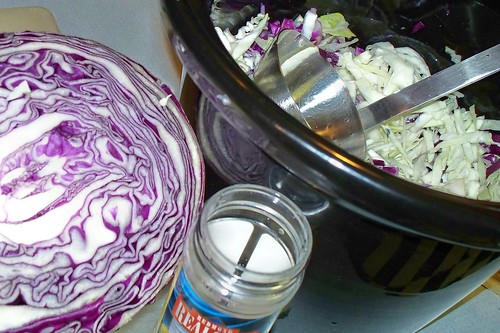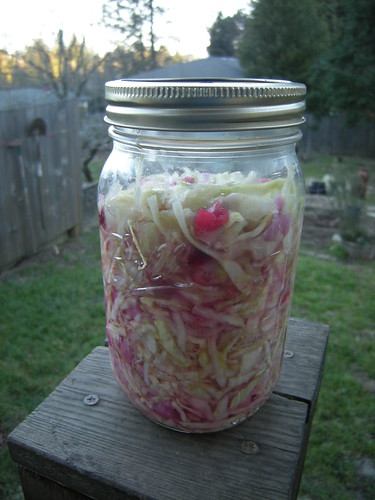This batch I made included the exotic addition of arame, a type of seaweed. Seaweed is a great thing to add to anyone's diet for the trace minerals and rare proteins and sugars. Arame, the common name for the kelp Eisenia bicyclis, is a rich source of calcium, zinc and iodine. It is also a good source of lignans which help fight cancer according to some studies.
 As expected, its taste is hardly noticeable in the highly flavored kimchi, though it is visually apparent as black threads in the cabbage mix.
As expected, its taste is hardly noticeable in the highly flavored kimchi, though it is visually apparent as black threads in the cabbage mix.Kimchi with Arame
Green/white cabbage
Carrots
Green Onions, or sliced white onions
Arame
Ginger
Garlic
Ground chiles
Sea Salt
Note on amounts: I don't give any. That's not the important part. To make one quart of kimchi I filled up a 3 or 4 quart mixing bowl with shredded veggies and seasonings. I would expect this is about 3/4 of a medium head of cabbage, 2 good sized carrots, 10 big green onions, a handful of arame, 3 inches of ginger, 5 cloves of garlic and enough chiles to make it red and spicy. Enough salt to make it "too salty to be tasty, not salty enough to be gross". See my blog posts on making sauerkraut, making pickles and my pickle FAQ for more information on my methods.
I used a mix of ground whole dried peppers and commercial New Mexico chile powder. In the past I have used a mix of chile flakes (like for pizza), cayenne, New Mexico Chile powder and paprika. You should use however much of whatever you have. This is artisanal cooking!
Shred the cabbage to your liking and either chop, plank or ribbon the carrots with a vegetable peeler. Chop up the green onions however you see fit and mince the ginger and garlic into matchsticks or tiny specks, as you see fit.
Put the handful of dried arame into a bowl of warm water and let sit for 5 or 10 minutes.
Toss all of the veggies together with the ground chiles and salt in a large mixing bowl or cooking pot, tasting as you mix. Pull the arame out of the water, squeezing it as dry as you can and leaving all the grit behind in the bowl. Mix that into the veggies and continue mixing, tasting and adding salt or chile powder as necessary.When the veggies and seasonings are mixed together well and good and salty you can either leave it in the bowl for an hour or so, or start packing it right away. I have gotten lazy and been leaving it in the bowl for a while to allow more liquid to come out of the veggies and make packing it easier.
When you are ready start spooning the mixture into your clean quart sized jar. Really pack it down in there. I use a regular mouth half pint jar to push it down into a wide mouth quart jar, but I've also used wooden meat mallets and those Chinese soup spoons to pack the veggies down. You really want to squeeze all the air out of the jar and let the liquid come up over the veggies. If you are squeezing and squeezing and still not getting liquid over, or at least to the top of your
 veggies you can add some more brine - salt added to water until it is too salty to be tasty but not so salty it makes you gag. You will end up with a wetter kimchi, but it will ferment just the same.
veggies you can add some more brine - salt added to water until it is too salty to be tasty but not so salty it makes you gag. You will end up with a wetter kimchi, but it will ferment just the same.Put the lid on your well packed veggies and leave them on the counter for a couple days. I find that ferments with ginger in them seem to get fermenting much more quickly. I did this kimchi a day after doing a plain cabbage kraut but the kimchi was ready to go in the fridge a day earlier. It was fizzy and the lid was popping and it was smelling quite sour. Put it in the fridge and start eating it whenever you want something spicy gingery sour salty.
I have been eating this kimchi with everything. My favorite is kimchi and macaroni and cheese, but I was also really impressed with kimchi and colcannon - mashed potatoes with sauteed cabbage and collard greens. It's of course great with any stir fried vegetables or Asian flavored meats, and I tossed a fair amount into a bowl of instant rice noodle soup the other night. I think the trick to incorporating fermented vegetables into your diet is just putting a spoonful on your plate with every meal. No matter what the food you are eating is, try it with some sauerkraut, pickles or kimchi. Maybe you won't like it and you don't eat that spoonful. Then again, maybe you will love it and have discovered a whole new taste sensation. And isn't that what life is all about?
Oh - while you are thinking about kimchi you should check out the Ultimate Kimchi Recipe. The listed ingredients may or may not be the actual ultimate kimchi but the directions certainly do. Enjoy.
This post is a part of Real Food Wednesday, check out everyone else's real food posts!



